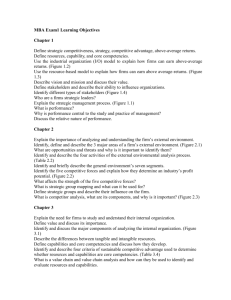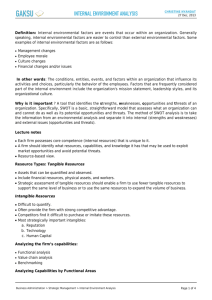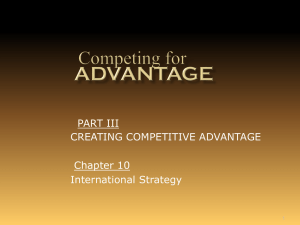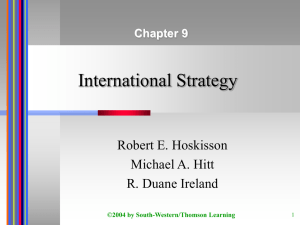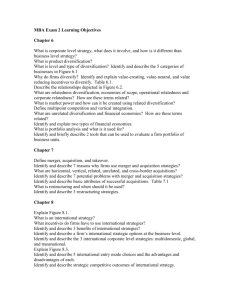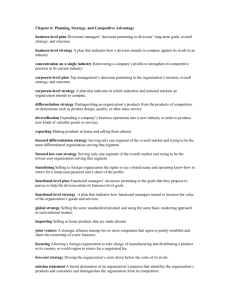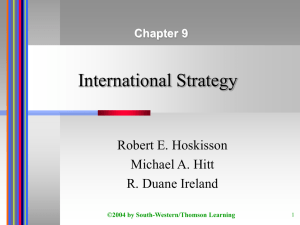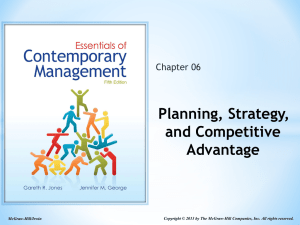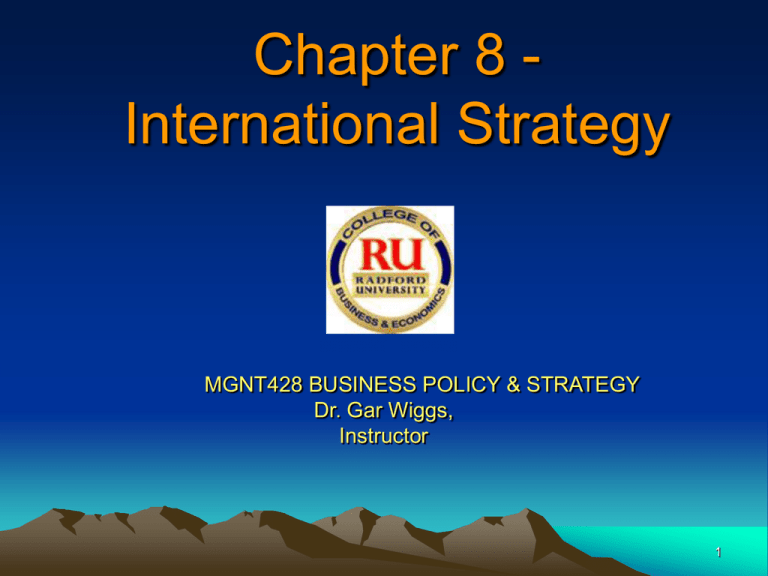
Chapter 8 International Strategy
MGNT428 BUSINESS POLICY & STRATEGY
Dr. Gar Wiggs,
Instructor
1
Knowledge Objectives
• Studying this chapter should provide you with
the strategic management knowledge needed
to:
– Explain traditional and emerging motives for firms to pursue
international diversification.
– Explore the four factors that lead to a basis for international
business-level strategies.
– Define the three international corporate-level strategies:
multidomestic, global, and transnational.
– Discuss the environmental trends affecting international strategy,
especially liability of foreignness and regionalization.
2
Knowledge Objectives (cont’d)
• Studying this chapter should provide you with
the strategic management knowledge needed
to:
Name and describe the five alternative modes for entering
international markets.
Explain the effects of international diversification on firm
returns and innovation.
Name and describe two major risks of international
diversification.
Explain why the positive outcomes from international
expansion are limited.
3
The Strategic
Management
Process
Figure 1.1
Copyright © 2004 South-Western. All rights reserved.
4
Opportunities and Outcomes of
International Strategy
Figure 8.1
5
Identifying International
Opportunities
• International strategy
– A strategy through which the firm sells its goods or
services outside its domestic market
• Reasons to having an international strategy
– International markets yield potential new
opportunities
– New market expansion extends product life cycle
– Needed resources can be secured
– Greater potential product demand
6
Classic Rationale for International
Diversification: Extend Product’s Life
Cycle
Product Demand
Develops and Firm
Exports Products
Foreign
Competition
Begins Production
Firm Introduces
Innovation in
Domestic Market
Firm Begins
Production Abroad
Production is standardized and
relocated to low cost countries.
7
International Strategy Benefits
• Increase market share
– Domestic market may lack the size to support efficient
scale manufacturing facilities
• Return on investment
– Large investment projects may require global markets
to justify the capital outlays
– Weak patent protection in some countries implies that
firms should expand overseas rapidly in order to
preempt imitators
8
International Strategy Benefits
(cont’d)
• Economies of scale or learning
– Expanding size or scope of markets helps to
achieve economies of scale in manufacturing
as well as marketing, R&D or distribution
– Can spread costs over a larger sales base
– Can increase profit per unit
9
International Strategy Benefits (cont’d)
• Competitive advantage through location
– Low cost markets aid in developing
competitive advantage by providing access to:
• Raw materials
• Lower cost labor
• Key customers
• Energy
10
Determinants of National
Advantage
SOURCE: Adapted with the permission of The Free Press, an imprint of Simon & Schuster Adult Publishing Group,
from Competitive Advantage of Nations, by Michael E. Porter, p. 72. Copyright ©1990, 1998 by Michael E. Porter.
Figure 8.2
11
Determinants of National
Advantage
• Factors of production: the inputs
necessary to compete in any industry
– Labor Land
Natural resources
– Capital Infrastructure
• Basic factors include natural and labor
resources
• Advanced factors include digital
communication systems and an educated
workforce
12
Determinants of National
Advantage (cont’d)
• Demand conditions: characterized by the
nature and size of buyers’ needs in the
home market for the industry’s goods or
services
– Size of the market segment can lead to scaleefficient facilities
– Efficiency can lead to domination of the
industry in other countries
– Specialized demand may create opportunities
beyond national boundaries
13
Determinants of National
Advantage (cont’d)
• Related and supporting industries:
supporting services, facilities, suppliers
and so on
– Support in design
– Support in distribution
– Related industries as suppliers and buyers
14
Determinants of National
Advantage (cont’d)
• Firm strategy, structure and rivalry: the
pattern of strategy, structure, and rivalry
among firms
– Common technical training
– Methodological product and process
improvement
– Cooperative and competitive systems
15
Selecting an International
Corporate-Level Strategy
• The type of corporate strategy selected will have an
impact on the selection and implementation of the
business-level strategies
– Some strategies provide individual country units with
the flexibility to choose their own strategies
– Others dictate business-level strategies from the
home office and coordinate resource sharing across
units
16
International Corporate-Level
Strategy
• Focuses on the scope of operations:
– Product diversification
– Geographic diversification
• Required when the firm operates in:
– Multiple industries, and
– Multiple countries or regions
• Headquarters unit guides the strategy
– But business or country-level managers can
have substantial strategic input
17
International
CorporateLevel
Strategies
Figure 8.3
18
Multidomestic Strategy
• Strategy and operating decisions are
decentralized to strategic business
units (SBU) in each country
• Products and services are tailored to
local markets
• Business units in one country are
independent of each other
• Assumes markets differ by country or
regions
• Focus on competition in each market
• Prominent strategy among European
firms due to broad variety of cultures
and markets in Europe
19
Global Strategy
• Products are standardized across national
markets
• Decisions regarding business-level
strategies are centralized in the home office
• Strategic business units (SBU) are
assumed to be interdependent
• Emphasizes economies of scale
• Often lacks responsiveness to local markets
• Requires resource sharing and coordination
across borders (hard to manage)
20
Transnational Strategy
• Seeks to achieve both global efficiency and
local responsiveness
• Difficult to achieve because of simultaneous
requirements:
– Strong central control and coordination to
achieve efficiency
– Decentralization to achieve local market
responsiveness
• Must pursue organizational learning to
achieve competitive advantage
21
Environmental Trends
• Liability of foreignness
– Legitimate concerns about the relative attractiveness
of global strategies
– Global strategies not as prevalent as once thought
– Difficulty in implementing global strategies
• Regionalization
– Focusing on particular region(s) rather than on global
markets
– Better understanding of the cultures, legal and social
norms
22
Choice of International Entry
Mode
Type of Entry
Characteristics
Exporting
High cost, low control
Licensing
Low cost, low risk, little control, low
returns
Strategic alliances
Shared costs, shared resources, shared
risks, problems of integration
Acquisition
Quick access to new market, high cost,
complex negotiations, problems of
merging with domestic operations
New wholly owned
subsidiary
Complex, often costly, time consuming,
high risk, maximum control, potential
above-average returns
Table 8.1
23
Dynamics of Mode of Entry
What’s the best solution?
Situation
Optimal Solution
The firm has no foreign
manufacturing
expertise and requires
investment only in
distribution.
Export
24
Dynamics of Mode of Entry
What’s the best solution?
Situation
The firm needs to
facilitate the product
improvements
necessary to enter
foreign markets.
Optimal Solution
Licensing
25
Dynamics of Mode of Entry
What’s the best solution?
Situation
The firm needs to
connect with an
experienced partner
already in the targeted
market.
Optimal Solution
Strategic Alliance
26
Dynamics of Mode of Entry
What’s the best solution?
Situation
The firm needs to
reduce its risk through
the sharing of costs.
Optimal Solution
Strategic Alliance
27
Dynamics of Mode of Entry
What’s the best solution?
Situation
Optimal Solution
The firm is facing
uncertain situations
such as an emerging
economy in its targeted
market.
Strategic Alliance
28
Dynamics of Mode of Entry
What’s the best solution?
Situation
Optimal Solution
The firm’s intellectual
property rights in an
emerging economy are
not well protected, the
number of firms in the
industry is growing fast,
and the need for global
integration is high.
Wholly-owned
Subsidiary
29
International Diversification and
Returns
• Expanding sales of goods or services across global
regions and countries and into different geographic
locations or markets:
– May increase a firm’s returns (such firms usually
achieve the most positive stock returns)
– May achieve economies of scale and experience,
location advantages, increased market size and
opportunity to stabilize returns
30
International Diversification and
Innovation
• Expansion sales of goods or services across global
regions and countries and into different geographic
locations or markets:
– May yield potentially greater returns on innovations (a
larger market)
– Can generate additional resources for investment in
innovation
– Provides exposure to new products and processes in
international markets; generates additional knowledge
leading to innovations
31
Complexity of Managing
Multinational Firms
• Expansion into global operations in different geographic
locations or markets:
– Makes implementing international strategy
increasingly complex
– Can produce greater uncertainty and risk
– May result in the firm becoming unmanageable
– May cause the cost of managing the firm to exceed
the benefits of expansion
– Exposes the firm to possible instability of some
national governments
32
Risk in the International
Environment
Political Risks
Economic Risks
Political risks include:
• Instability in national governments
• War, both civil and international
• Potential nationalization of a firm’s resources
33
Risk in the International
Environment
Political Risks
Economic Risks
Economic risks are interdependent with political
risks and include:
• Differences and fluctuations in the value of
different currencies
• Differences in prevailing wage rates
• Difficulties in enforcing property rights
• Unemployment
34
Risk in the International
Environment
Figure 8.4a
35
Risk in the International Environment
(cont’d)
Figure 8.4b
36
Limits to International Expansion
• Management Problems
– Cost of coordination across diverse
geographical business units
– Institutional and cultural barriers
– Understanding strategic intent of competitors
– The overall complexity of competition
37

